Silkworm pupae - a dish that encapsulates the quintessence of the countryside
Silkworm pupae are now considered a simple dish, containing both the quintessence of the countryside, as well as memories, culture, and familiar images of the family. Silkworm pupae have a rich, crispy, and nutritious taste and are present in everything from family meals to "standard" drinking menus.
Here are 7 delicious dishes made from silkworm pupae , simple to prepare, easy to make at home and extremely delicious with rice.
1. Fried silkworm pupae with lemon leaves – national dish
This traditional method is the most popular. Fresh pupae after being washed are boiled, seasoned and then fried until golden brown in a pan with fried onions. When the pupae start to crackle and the aroma spreads throughout the kitchen, sprinkle in julienned lemongrass leaves, stir quickly and turn off the stove.
Tips:
- Only sprinkle lemon leaves after turning off the stove to preserve the essential oils and natural aroma.
- The fatty taste of pupae mixed with the aroma of lemon leaves, adding a little salty fish sauce - eaten with white rice, or with wine, both are very delicious.
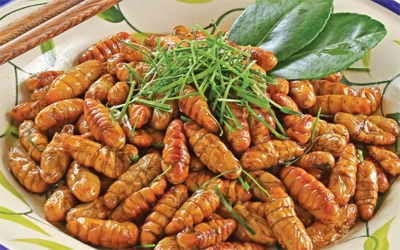
Silkworm pupae fried with lemon leaves. Photo from internet
2. Stir-fried silkworm pupae with betel leaves – a great beer snack
This dish is very popular with men.
Slice the betel leaves, boil the pupae and stir-fry with onions, garlic and spices. When almost cooked, add the betel leaves and stir-fry until fragrant.
Piper lolot has a warm nature, helps neutralize the fat of pupae, creates a characteristic aroma and aids digestion.
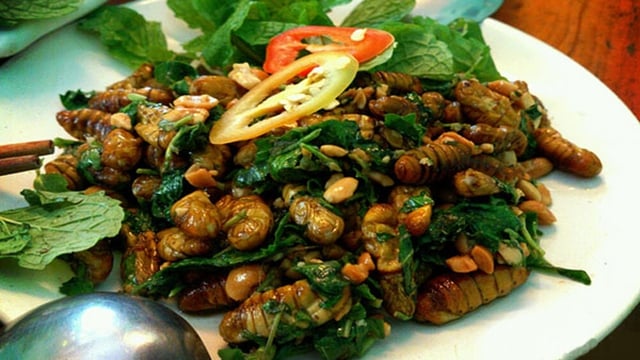
Silkworm pupae stir-fried with betel leaves. Photo from internet
3. Deep fried silkworm pupae - crispy and delicious
Fried silkworm pupae is an option not to be missed.
Clean silkworm pupae, marinate with spices, dip in beaten eggs, roll in breadcrumbs and fry until golden brown.
Deep-fried silkworm pupae have a crispy outer shell and soft, fatty inside. This dish is also loved by children with chili sauce or mayonnaise, and is even more popular with drinkers.
More specifically, fried silkworm pupae can be eaten with green cabbage rolls, creating a light taste and balanced nutrition.
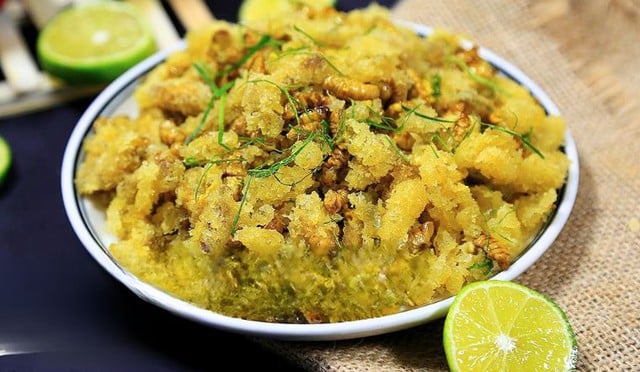
Deep fried silkworm pupae. Photo from internet
4. Braised pupae with fish sauce
This is a true "rice-eating" dish. The pupae are marinated with good fish sauce, pepper, a little sugar, and simmered until it thickens. The rich, slightly spicy, and fatty flavor makes you want to scoop it up forever.
This dish is eaten with pickled cabbage and hot rice - a rustic dish but very appealing to the taste buds.
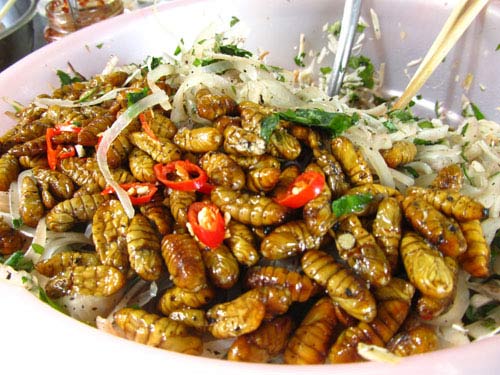
Silkworm pupae mixed with young jackfruit salad. Photo from internet
5. Silkworm pupae salad – unique and refreshing
Silkworm pupae can be used to make salad, an extremely "addictive" dish for everyone.
Boil pupae, let cool, mix with green mango, Vietnamese coriander, fried onions, roasted peanuts, fish sauce, garlic and chili.
The fatty - sour - spicy - aromatic flavors blend together, creating a delicious and unique appetizer before the party.
You can also mix young silkworm pupae salad with grapefruit, young silkworm pupae salad with young jackfruit... very unique and addictive.
6. Pupae porridge – nutritious, light on the stomach
Pupae porridge is popular with many elderly people and children because it is easy to digest and provides a lot of protein.
Blend the silkworm pupae (or pound lightly) in a mortar and stir-fry with onions, then add to the boiling porridge. You can add some Malabar spinach, jute, or squash (depending on taste).
Note: For first time users, only use a small amount to test your body's reaction.
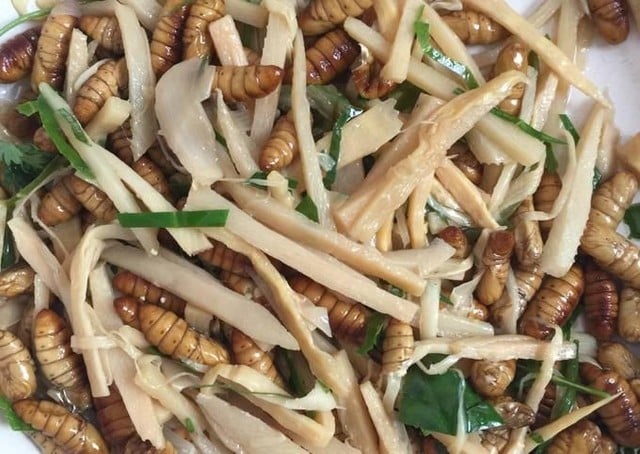
Stir-fried silkworm pupae with pickled bamboo shoots. Photo from the internet
7. Stir-fried pupae with sour bamboo shoots – delicious on a cool day
Stir-fry silkworm pupae, then add drained pickled bamboo shoots and stir-fry with spices. Add some herbs like coriander and chili peppers to make the dish more appealing.
Note: Stir-fry the pupae separately until firm, then add the bamboo shoots to avoid the fishy smell. The light sourness of the bamboo shoots combined with the fatty taste of the pupae creates an irresistible harmony.
Some localities also have dishes such as stir-fried silkworm pupae with corn, stir-fried silkworm pupae with pineapple...
In short, silkworm pupae are delicious and nutritious, but they only really bring out the benefits when you eat them with the right person – the right way – the right dosage. When eating, pay attention to your body, underlying diseases and how to prepare them so that this dish is both delicious and safe for the whole family.
Silkworm pupae dishes are delicious, but these 5 types of people should limit their intake
Although silkworm pupae are a delicious, nutritious, and appetizing dish, you should only eat them 2-3 times a month, no more than 100-150g/time. Not everyone is suitable to eat silkworm pupae. The following people should not eat or limit eating silkworm pupae to ensure their health:
1. People with allergies:
Silkworm pupae contain many strange proteins that can easily cause allergic reactions such as rashes, hives, stomachaches, difficulty breathing, etc. Those who have a history of allergies to seafood, insects or strange proteins need to be extremely careful.
Therefore, if you eat silkworm pupae for the first time, you should eat a small amount to "test" your body's reaction.
2. People with gout
Silkworm pupae contain very high levels of protein, especially purine – a component that is easily converted into uric acid in the blood. Eating silkworm pupae can cause gout sufferers to experience severe pain within a few hours.
3. Children under 2 years old
The digestive system of young children is still weak and not yet suitable for digesting the high amount of protein and fat in pupae. Eating pupae too early can cause indigestion, stomachache or allergies.
4. Newborn women
Northerners often avoid giving pupae to women after giving birth because they can cause bloating, indigestion, and abdominal discomfort. Some places replace lemon leaves with Vietnamese coriander to make it easier to digest, but it is best to avoid pupae during the 1-2 months after giving birth.
5. People with digestive disorders
For those with bloating, diarrhea, acute colitis - eating pupae can make the condition worse because the indigestible protein puts pressure on the digestive system.
Source: https://giadinh.suckhoedoisong.vn/top-7-mon-nhong-tam-dan-nhau-de-ghien-nguoi-thanh-pho-cung-me-lai-rat-de-lam-tai-nha-172250709182139272.htm

















































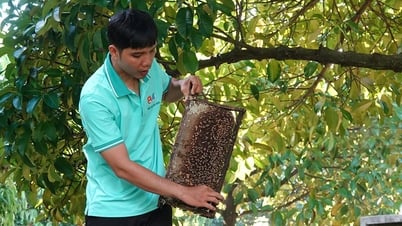


















![[Photo] International community congratulates Vietnam on having more landscapes recognized as World Cultural Heritage](https://vphoto.vietnam.vn/thumb/402x226/vietnam/resource/IMAGE/2025/7/13/58ec71f73ae644bfb5bab9c99043bb7d)

































Comment (0)